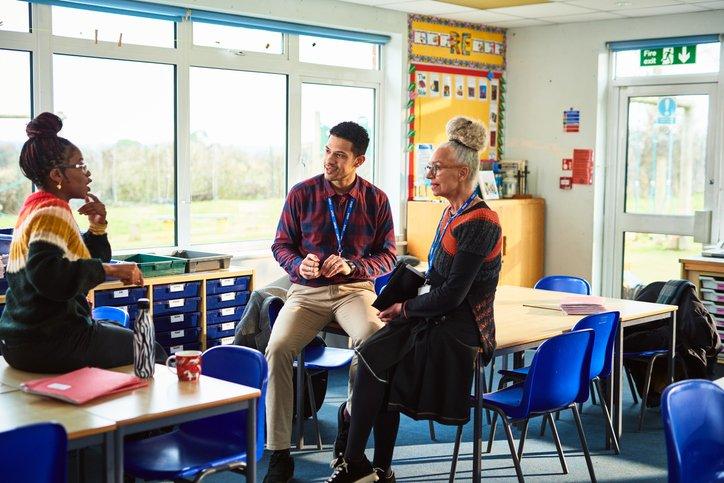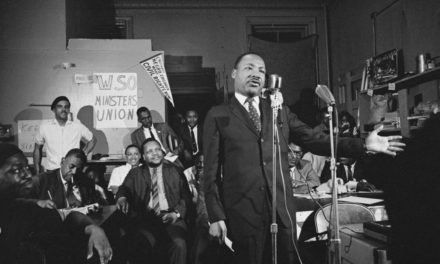
Recently, one of my coachees, a K-12 school founding leader, cried profusely as she shared with me in an empathy interview, “I have been complicit in causing undue harm and trauma to young Black boys because I thought I was disciplining them.” I responded: “You can name and unshame that behavior by acknowledging that bias, and leading yourself and others to disrupt systemic, oppressive behavior.” As she cleaned her face with the tissue she grabbed from the tissue box, I heard: “I really want to, but I don’t know how to have discussions about race without feeling uncomfortable or dealing with conflict that comes from those conversations.”
School leaders are usually not trained to facilitate conversations about race that promote the changing of “beliefs, behaviors, and ways of being” (Aguilar, 2020, p. 34). In a 2020 survey conducted by Education Week, only 2% of K-12 leaders in the U.S. indicated they feel comfortable about engaging in conversations about race (Superville, 2020). Furthermore, most principal preparation programs are not designed with any coursework or training in antiracism (Carmona, 2022; Edeburn, 2022). Another poignant study following the murder of George Floyd posed the question: “How should I address systemic racism with my school community?” and found that only one in three K-12 institutions “released a public statement addressing racism, and of the institutions that released a statement, only half cited any specific short-term or long-term actions to advance racial justice” (EAB, 2023).
As a transformational leadership coach, most of the K-12 school leaders I work with do not have any formal public statements that declare their stance on antiracism as a value at their schools. Antiracist beliefs and action steps are often shared in confidential coaching sessions, but usually never realized within their school contexts. Without a transformation of beliefs, behaviors, and ways of being in conversation to action, students, teachers, or school leaders will not actualize the equitable schools they so desire to lead (Shields, 2019; Shields & Hesbol, 2020). Hence the importance of “Calling Out” and “Calling In” to cultivate, nurture, and sustain an antiracist culture of accountability.
Harvard University’s Diversity, Inclusion and Belonging Calling In and Calling Out Guide defines calling out as “bringing public attention to an individual, group, or organization’s harmful words or behavior” and calling in as “an invitation to a one-on-one or small group conversation to bring attention to an individual or group’s harmful words or behavior, including bias, prejudice, microaggressions, and discrimination.”
Calling others in and out both require building a stamina of courage and boldness to address in-the-moment statements and behaviors that are misaligned with the equitable and antiracist cultures that many school leaders desire. However, this will naturally prove challenging when research identifies that K-12 leaders spend a substantial amount of time being told not to discuss race and learning to avoid any conversations about racial tensions (Jakes, 2022; Marshall, 2023; Scussel & Norris, 2023). Organizational conditioning, school policies and systems, and fear are three of the root causes of why school leaders are uncomfortable talking about race (Cooney, 2021; Furfaro, 2020; Oluo, 2019).
“In order to create a cohesive community and a consensus on how to proceed, people must have the occasion to engage in democratic discourse about the real stuff of teaching and learning. Part of this democratic discourse is providing enough time and space in Courageous Conversation so that every educator’s perspective and experience can be listened to and affirmed” (Singleton, 2014, p. 29).
In my empathy interviews with school staff, two educational leaders stated how conversations about race need to be an “intentional and deliberate” practice within their school buildings:
- “It’s not enough to just discuss but action must be followed to ensure DEI is happening in an authentic way.”
- “I need to be different in how I approach and manage these conversations so that my whole team can lean in and buy-in.”
This work is critically important for K-12 school leaders because it has a direct correlation to teacher and student belonging, inclusion, and acceptance. Given the plethora of research that confirms the lack of antiracist training, fear and conditioned discomfort around talking about race as a critical step, (Coles-Ritchie & Smith, 2018; Hettinger and Roegman, 2018), schools that value building cultures of equity are more likely to build in systems that are continually introspecting, and reflecting how they are authentically sustaining equitable practices (Aguilar, 2020; Lindsey et al., 2019; Singleton, 2014).
So, how does calling in become a habit of mind and heart? Firstly, a school leader must commit to being the catalyst that leads this change process by being vulnerable with their staff about their biases and prior mistakes. Developing a cadence with a transformational leadership coach who challenges statements that are racist, biased, or perpetuate oppressive systems through inquiry-based questioning and coach-driven action steps can facilitate a humanistic approach. Transparency and accountability from the leader models how teachers, students, and support staff are going to build trust and comfortability to do the same. In the New York Times bestselling book SWITCH: How to Change Things When Change Is Hard, the chapter titled “Build Habits” (2010) states, “the habit should serve the mission” (p. 216). Leveraging this seemingly radical change in traditional thinking and behavior requires connecting to the mission of the school — which usually contains some iteration of words that promote diversity, equity, inclusion, belonging, acceptance, and social justice.
Secondly, cultivating and nurturing a culture of comfortably speaking about race and making everyone accountable to rejecting deficit mindsets takes patience, persistence, diligence, and tenacity. Spending time before the school year begins with the school leaders and staff discussing, reflecting, disagreeing, experiencing conflict, and leaning into discomfort sets the precedent for crafting a necessary space to have these conversations with support from each other. Cultivating strength-based terminology and growth mindsets are essential to establishing positive thoughts and behavior for equitable culture change. Modeling, shadowing, and encouraging intentional learning communities (ILCs) that create opportunities to learn, practice, and receive feedback in the moment, promote a spirit of collaboration as the entire school develops the chops to authentically call out and call in.
An example of how a school leader can establish a research and evidenced-based practice while nurturing this culture is to engage in Constructivist Listening. Currently, I am facilitating 18 school leaders in a year-long DEIBAJ themed constructivist listening dyad experience as a lynchpin for building comfortability to discuss race. Four months in, school leaders are exclaiming: “before these conversations, I never thought about how important it is for me to discuss my fears and biases.” “I am happy to have a place where I can freely share with a peer and think through what I am feeling and how to make this a non-negotiable action with my school team.” A visible and felt deliberate culture cannot happen without the intentionality of a transformational methodology and approach.
To make calling out and calling in more than buzzwords, action has to be aligned with the naming and unshaming that comes from coaching and reflective listening. Mere discussions and awareness-raising does not constitute a paradigm shift in thinking and behavior. Embedded systems that converge with the intended culture are required for sustainability. Supporting and empowering a fail forward philosophy gives the entire school team flexibility to listen, learn, and lean into herculean growth. Additionally, school leaders and their teams must dive deep into antiracist professional development that challenges their colonialist conditioning stemming from “traditional” education models and theories.
After examining my own educational biases, during the yearlong shut-in made necessary by the pandemic, I myself have taken steps to build my own learning: working with a leadership coach of my own, engaging in peer-to-peer learning opportunities such as an equity facilitator community of practice (CoP), attending professional development like the National Equity Projects Coaching for Equity Institute, serving as a leader of a BIPOC coach affinity group, and becoming a member of national associations where my words and actions impact people, schools, and organizations. No longer could I proudly tout my “I am a child advocate and BIPOC youth activist” mantra without mustering the courage and boldness I needed to lead this work. That included speaking up and challenging school personnel about how their decisions impact the students they serve. School leaders, who are made to believe they wear a cape of superpowers, should use their powers for good. That good erupts from a combination of facilitative, directive, and transformative influence that subtly persuades, without coercion, an entire school team to willingly make the vision and mission of an equitable antiracist school culture come into fruition.
I believe it is an educator’s role and purpose to:
- Make sure that students experience love, joy, acceptance, and belonging at school
- Serve as role models against the tyranny and injustice that society is encouraging
- Embody the laws of human nature that demonstrate that instinctively all human beings seek to be heard, valued, and understood.
Calling out and calling in as accountability practices promote all of this in a compassionately conscious manner, where students in turn see how the world can be improved upon from the one they live in. Together we can work toward a world where everyone is an equal, celebrated for their uniqueness, and judged solely by their character, ethics, and integrity.
References
Aguilar, Elena. Coaching for equity: Conversations that change practice. John Wiley & Sons,
2020.
Carmona, K. (2022). The illusion of progress: The disconnect between the anti-racist values
professed in teacher education programs and the white curriculum that negatively impact students of color. College of Education Theses and Dissertations. https://via.library.depaul.edu/soe_etd/243
Coles-Ritchie, M., & Smith, R. R. (2017). Taking the risk to engage in race talk: Professional
development in elementary schools. International Journal of Inclusive Education, 21(2),
172-186. https://www.tandfonline.com/doi/full/10.1080/13603116.2016.1193562
Cooney, C. (2021). 55% of people are to scared to talk about diversity and inclusion in the workplace for fear of saying the wrong thing. https://righttracklearning.com/fear-of-saying-wrong-thing-at-work/
EAB. (2023). What K-12 leaders have done to address racism in 2020- and is it
Edeburn, E. (2022). Principal preparation: The intersectionality of race and education justice in
public elementary and secondary schools. Journal of School Administration Research and
Development, 7(2), 1112-115.
Furfaro, H. (2020). To understand structural racism, look to our schools.
Heath, C. & Heath, D. (2010). Switch: How to change things when change is hard.
Currency Press.
Hettinger, C. & Roegman, R. (2018). Talking In Whispers: How school leaders approach and
discuss race. Journal of Purdue Undergraduate Research, (8) pps. 17-23.
Jakes, B. T. (2022). The Effects of Social Conditioning on Education. Shatter the System: Equity Leadership and Social Justice Advocacy in Education, 7. https://www.seattletimes.com/education-lab/to-understand-structural-racism-look-to-our-schools/
Lindsey, D. B., Martinez, R. S., Lindsey, R. B., & Myatt, K. T. (2019). Culturally proficient
coaching: Supporting educators to create equitable schools. Corwin.
Marshall, J. (2023). Barriers and Facilitators to Racial Equity in K-12 Education: An integrative
Review.
Oluo, I. (2019). So you want to talk about race. Hachette UK.
Scussel, E. C., & Norris, J. E. (2023). ” That Sounds Scary, Let’s Ban It:” Analyzing Manufactured Ignorance & the Attack on Critical Race Theory in K-12 Schools. Thresholds in Education, 46(1).
Shields, C. M. (2019). Becoming a transformative leader: A guide to creating equitable schools.
Routledge.
Shields, C. M., & Hesbol, K. A. (2020). Transformative leadership approaches to inclusion,
equity, and social justice. Journal of School Leadership, 30(1), 3-22.
Singleton, G. E. (2014). Courageous conversations about race: A field guide for achieving
equity in schools. Corwin Press.
Superville, D. (2020). Principals need help building anti-racist schools. https://www.edweek.org/leadership/principals-need-help-building-anti-racist-schools/2020/09


















